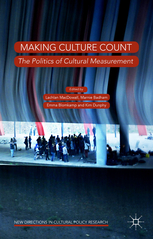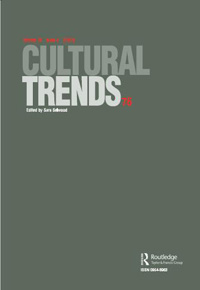Here Susan Oman reposts her review of Making culture count: the politics of cultural measurement, edited by Lachlan MacDowall, Marnie Badham, Emma Blomkamp and Kim Dunphy, London, Palgrave Macmillan, 2015, ISBN 978-1-137-46457-6.
 Making culture count: The politics of cultural measurement focuses on the ever-present issues of measurement and meaning in articulating value for cultural policy practices and research. The book is split into three sections. Part I offers “Critical accounts of the history and politics of cultural measurement”, while Part II is called “Making culture count in political contexts and discourses” and the final section presents a number of “Critical and creative approaches to cultural measurement practice”. These sections are inevitably as much crosscutting themes as they are expedient subdivisions to an ambitious 300 pages of contributions from over 20 authors.
Making culture count: The politics of cultural measurement focuses on the ever-present issues of measurement and meaning in articulating value for cultural policy practices and research. The book is split into three sections. Part I offers “Critical accounts of the history and politics of cultural measurement”, while Part II is called “Making culture count in political contexts and discourses” and the final section presents a number of “Critical and creative approaches to cultural measurement practice”. These sections are inevitably as much crosscutting themes as they are expedient subdivisions to an ambitious 300 pages of contributions from over 20 authors.Belfiore’s foreword roots the collection in a cross-national collaboration and international conference held in Melbourne in 2012. The transnational context refreshes cultural policy practices, which rarely wander far from home. In the introduction, one of the editors states that cultural measurement “transcends singular disciplines, institutional locations and conceptual aims” (p. 2). It is to the credit of the collection that there is also great variation in the chapters’ approaches.
Of course, if cultural measurement transcends national boundaries, so do problems of measurement and meaning in more local geographies. In the final chapter, Sophie Hope discusses the “grey areas” of cultural commissioning for communities and how to evaluate this practice. She explains that it may have looked like communities were “channels for effecting change, but they were perhaps only ever able to be performances of participatory democracy” (p. 295). Her chapter is one of the most interesting critical contributions to understanding possible “new directions” for appraising cultural interventions.1 It forefronts the contributions that the “mischief and misbehaviour” (p. 293) of art can make to understanding evaluation by way of its potential for disruption, and how that interacts in complex ways with stakeholders’ hopes for change.
Harriet Parsons also plays with “political mischief”, opening with the beginnings of utilitarian units of measurement in the nineteenth century. Her narrative then pleasingly leads the reader through controversial contemporary artist Serrano’s Piss Christ, past McCarthy’s Butt Plug2 and back to Jeremy Bentham and the “whims of moral sense”. Parson intersects art, philosophy and politics to indicate the promise of contemporary art practice to “hold cultural values up for examination” (p. 56) in her endeavour to “resolv[e] inherent flaws in the terms of the debate” on cultural value (p. 53).
Parsons concludes that “cultural values provide the concepts of communication” (p. 63) and O’Brien and Lockley’s chapter explains how the idea of “cultural value” is communicated in, and changed by, contemporary social settings. Their analysis of social media exchanges via Twitter is illustrated by data visualisations of network relationships and word usage. It contributes an informative intervention into the cultural value debate, as the authors describe the term as at “present, [an] incoherent and contradictory form” (p. 101). O’Brien and Lockley demonstrate how conceiving of the Twitter hashtag #culturalvalue as a social device illuminates the detrimental effects of the term’s popularity on its meaning and utility. Their intention is to clarify how advocacy has conflated efforts to assert value with endeavours to measure it and how this confuses, rather than elucidates, the meaning and value of culture.
Much of the book highlights how complications in working definitions aggravate practice-based issues of understanding, measuring and communicating cultural change. In spite of this, some chapters would benefit from more explicit definitions and more figures. Furthermore, limited indexing makes it difficult for the reader to locate related examples, explanations and meanings elsewhere in the book. This is particularly true in the case studies, which refer to particular models as improvements on the status quo. While the problems with prior models may be quite clearly demarcated, the authors’ examples of adaptations to these working practices are not drawn out as clearly as they could have been. This leaves the reader working harder than they should to grasp an actual measure of meaningful change in the work presented, which is a shame, given the quality of the material.
“Defining progress is a political act”, Woolcock and Davern emphatically explain (p. 129). I read their valuable account of well-being and progress with great interest, as it is particularly relevant to my own research. The authors present a useful context to what they call “creative accounts” of progress, pointing out the importance of questions such as: “Who decides what progress is?”, and “progress for whom”? The section (Re)defining progress: a democratic task explores how “control over measurements and definitions [ … ] has been seen as a key tool of political power. This is especially true of the act of defining and measuring progress” (pp. 129–130). The crux of the chapter is that community indicators are better; more democratic. Yet the chapter would benefit from a clearer account of the extent to which a community indicator is controlled by the community, or of how much community input there is in descriptions of that community. While community indicators are admittedly a complex phenomenon to describe within the limited purview of each chapter, they are unfortunately not clarified in the chapters that specifically do explore them (e.g. Chapters 2 and 12), and so the power of naming and meaning remains rather undemocratically very much in the hands of the authors.
Communities’ involvement in their indicators, together with how the kinds of data that community indicators produce actually democratise the picture of cultural production and consumption, remains unclear in the case studies. The Community Indicators Victoria project (CIV) that the authors draw on relies on “75% of existing administrative data from the Australian Bureau of Statistics or government departments” [my emphasis], and community input into approaches in “the large scale population-based surveys conducted independently by CIV or VicHealth” (p. 137) is also unexplained. Community involvement in the inclusion of the arts and culture in the CIV framework on community well-being is indistinguishable from a narrative which explains that the arts and culture were incorporated “in recognition of the importance of these activities for community identity and the role of art, film and literature for their interpretive communication on contemporary social issues” (p. 138). To return to the authors’ first question, one might justifiably wonder whose recognition, activities and identities were actually at play here.
Given that the difficulty in explaining community indicators lies in their inherent specificity, the case study could have more clearly illustrated the democratic possibilities. For example, a diagram or table outlining the CIV’s domains and indicators, including the particulars on community involvement, would have greatly improved communication of the “new directions” in democratically defining progress by way of community engagement, even if it were not possible to explain the nuances of the community indicator movement in its entirety. Other chapters also refer to the CIV (Badham, p. 197) but also neglect to list or illustrate the indicators. While both Badham’s and Woolcock and Davern’s chapters were extremely informative, they could still have more clearly expressed the concerns of their chapter through more specific examples to avoid criticisms of what Hope refers to as “performances of participatory democracy” on the penultimate page of the book (p. 295).
Hope’s chapter, based on her PhD case study in Greenwich, London, provides a valuable contribution to the collection. Its wilfully negative explanation of aspects of cultural commissioning and subsequent evaluations present a missed opportunity for an expedient editorial conclusion to one of the first books in this new series: a short reflection could have drawn together the various case studies, activist interventions and frameworks to suggest how culture can impact in new directions, despite new hurdles. A conclusion might also have helped to contextualise some of the examples and case studies (largely from 2010). Given the significant changes in these economic, cultural, political and social landscapes since 2010, to not acknowledge their impact feels a little remiss in a book on the politics of cultural measurement.
Having said that, many of the chapters offer comprehensive histories of forms of evaluation and provide innovative contributions to debates on the various roles of “the cultural” in understanding and encouraging positive social change, with an added bonus of rewarding bibliographies for further reading. The collection also presents some thought-provoking responses to many current problems with the terms of the arguments, be they economic, cultural, political or social (as much as those can be separated), in attempts to move the debate forward. As such, the book offers a précis of a moment for Cultural Policy Studies, across the book’s broad range of themes and “diverse essays” connected to the “history, theory and purposes” of cultural evaluation. I would recommend this book for cultural policy scholars and practitioners, and even activists, as well as those interested in indicators of the social and development studies more broadly.
To cite the review: Susan Oman (2016): Making culture count: the politics of cultural measurement, Cultural Trends To link to this article: http://dx.doi.org/10.1080/09548963.2016.1170920
Notes
 To cite this article: Susan Oman (2016): Making culture count: the politics of cultural measurement, Cultural Trends To link to this article: http://dx.doi.org/10.1080/09548963.2016.1170920
To cite this article: Susan Oman (2016): Making culture count: the politics of cultural measurement, Cultural Trends To link to this article: http://dx.doi.org/10.1080/09548963.2016.1170920